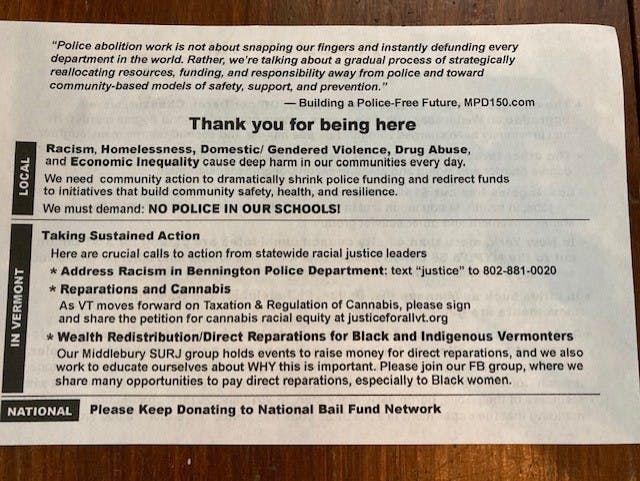“Protests Work!” read the flyer handed out at a vigil in downtown Middlebury last Sunday night. Roughly 500 people gathered at College Park and along Cross Street to denounce police terror against Black communities and bodies.
Sunday’s event follows a vigil held on May 30 that drew roughly 375 participants. The Middlebury chapter of Showing Up for Racial Justice (SURJ) organized a second event after the first gathering’s popularity and again asked protestors to wear masks and maintain social distancing. SURJ members also distributed flyers with actionable steps to take against racism, a list of positive advances made in the past weeks and solidarity tools for White allies.
“I have been heartened by the mobilization of people around the globe, but especially of people in my own little community of Middlebury who are demanding that the white supremacy and racial oppression that lay at the core of American society must end,” said Bill Hart, professor of history and director of Black Studies. “I showed up to show that the Black bodies of Middlebury students, faculty and staff, and of Black people in the community, matter — that my black body matters.”
The town of Middlebury is a small community, and “no one is under the illusion that standing on the Cross Street Bridge will end police terror,” said Jamie McCallum, professor of sociology. However, McCallum noted that vigils and protests show solidarity, love and respect for the larger uprisings going on around the country and the world.
“In a vastly, vastly white place like Middlebury, even something small like safely standing with Black Lives Matter flags in downtown goes a long way towards making me feel at ease here,” said Kemi Fuentes-George, professor of political science. Fuentes-George recounted previous instances of harassment and being called the n-word in downtown Middlebury.

However, attending protests and vigils is only the bare-minimum in protesting white supremacy, according to Lana Povitz, visiting assistant professor of history. Povitz expressed disappointment that the organizers of Sunday’s gathering did not take the opportunity to ask more of participants or advertise upcoming events or actions.
“This was a crowd that would probably have said ‘yes’ to any number of asks,” Povitz said. “I wonder when we might be ready for something a little less anodyne. How can we disrupt business as usual?”
For Fuentes-George, the vigil went as expected. “We’re not going to get the kinds of demonstrations that we’re going to get in New York for many reasons, including that it’s not very diverse,” he said.
“I understand that there were some people who felt disappointed with how the protest went, that it wasn’t radical enough, but the reality is that’s the town that we live in,” Fuentes-George added.

McCallum hopes the vigils will encourage people to step up their commitments for racial justice in other ways. Hart remains “cautiously optimistic” and questions what real change the growing movement will bring about.
“The image of Derek Chauvin’s knee on George Floyd’s neck reminded my mother of what her father — my grandfather — often told his children: the White man will forever keep his boot on the Black man’s neck,” Hart said. “Floyd’s murder reminds us that little seems to have changed in White attitudes toward Black lives and bodies.”
Some have described the past decade as a turning point for racial justice, Hart said, and he “certainly hope[s] so,” but history has shown a trend of White America resisting change and reasserting White privilege. Hart cited the Civil Rights legislation in the 1950s and 1960s, the Great Society, Affirmative Action and the election of President Barack Obama as only a few examples.
“Meaningful change will only come when Black Americans build alliances with Brown and other disfranchised peoples as well as with White allies, and with one powerful voice, as now, demand massive, transformational change,” Hart said, “and when White Americans re-examine everything they think they believe in, to paraphrase James Baldwin’s “The Fire Next Time.””
“Healing without justice is no healing at all,” Hart said.
Second Black Lives Matter vigil exceeds first, draws 500 participants

Courtesy of Joanna Colwell
Courtesy of Joanna Colwell
Comments



